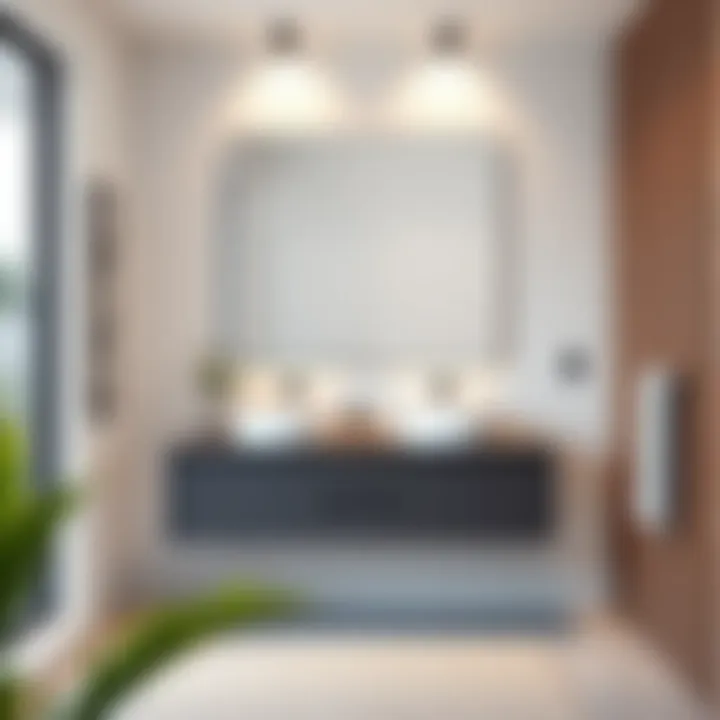A Guide to 18-Inch Floating Vanities for Modern Spaces


Intro
In today’s world, where space is often at a premium, the 18-inch floating vanity emerges as a remarkable solution for those looking to blend functionality with aesthetic beauty. These vanities—and their modern façade—offer a fresh take on bathroom design, especially beneficial when dealing with compact areas. By elevating your storage solutions through floating fixtures, you can achieve a seamless appearance that visually expands your space. They are particularly suitable for convey a minimalist vibe, which continues to gain traction in contemporary home interiors.
Floating vanities engage the user in a thoughtful dialog of design and utility. They exemplify how style doesn’t have to sacrifice convenience. It’s not just about arguably trendy appearances; these structures come with a host of advantages that transform typical bathrooms into stunning retreats. From clever material options to savvy installation tips, this guide will walk you through all necessary components to enhance your living environment with these elegant fixtures.
Foreword to Floating Vanities
Floating vanities, while perhaps not the first piece of furniture that comes to mind when discussing bathroom design, are suddenlly gaining traction among homeowners, designers, and real estate enthusiasts. They offer a unique blend of style and practicality, especally suited for modern-day living, particularly in smaller spaces. This section delves into what exactly a floating vanity means, the benefits of their design, and how they contribute to a bathroom’s overall aesthetic.
What is a Floating Vanity?
A floating vanity is a wall-mounted bathroom storage unit that appears to 'float' above the floor, eliminating the need for traditional legs or a pedestal base. This sleek design not only creates visual space, making your bathroom feel larger, but also simplifies cleaning, as there’s no base to get in the way. When you look at a floating vanity, you might see everything from minimalist setups boasting clean lines to more decorative iterations that showcase artistry and innovation. Regardless of their look, the fundamental concept remains:
- Supported by the wall: A floating vanity is anchored into wall studs, ensuring stability while leaving the floor area unobstructed.
- Variety of styles: These units come in a plethora of design aesthetics, from ultra-modern to rustic.
- Flexible positioning: Adjustable height options allow homeowners to customize their vanity's placement for comfort.
Benefits of Choosing Floating Designs
Floating vanities come with a host of advantages that make them appealing for contemporary designs:
- Space-Saving: One of the major draws of floating vanities is their ability to create the illusion of more space. By allowing the floor area to be visible, they can make even the tiniest bathrooms feel less cramped.
- Easier to Clean: Since they are elevated off the ground, these units allow easy access for cleaning underneath. No more squatting down for those hard-to-reach spots!
- Modern Appeal: Their unique design often aligns with current design trends, making them a connectable piece in modern decor schemes.
- Customization Options: Floating vanities can be tailored to fit particular design needs, whether you need additional storage, specific colors, or unique finishes. They're readily adaptable to align with other elements in the bathroom.
- Accessibility Features: For households with varied mobility capabilities, floating designs can be positioned at heights' customization to enhance usability.
"Floating vanities represent not just a trend but a shift toward more thoughtful and functional bathroom design."
Understanding 18-Inch Dimensions
Grasping the significance of 18-inch dimensions is key when considering floating vanities. Such measurements are not just numbers; they inform essential decisions that can ultimately enhance the functionality and aesthetics of a bathroom. This section dives into how these dimensions determine overall style and utility, and why they matter for various bathroom layouts.
Ideal Bathroom Sizes for 18-Inch Models
When selecting a floating vanity, understanding the specific space it will inhabit is crucial. An 18-inch vanity typically serves as an excellent choice for bathrooms that straddle the line of being compact yet stylish. Generally, these models work best in small to medium-sized bathrooms, where space is at a premium without sacrificing design.
A good rule of thumb when contemplating size:
- Powder Rooms: Perfect fit! The limited square footage can shine with a sleek design.
- Full Baths: If the layout allows, this size offers enough surface area for essential items without overwhelming the space.
- Guest Bathrooms: Trendy and functional, a floating vanity here can impress while remaining practical.
However, it’s wise to also measure surrounding features like doors, access points, and other fixtures. Doing this ensures the vanity won’t congest the flow of traffic in the bathroom.
Furthermore, think about storage needs in conjunction with size. If you find yourself in a situation where aesthetics and utility collide, an 18-inch floating vanity can cleverly balance both by incorporating drawers or open shelving for your toiletries.
Space Optimization Strategies
Maximizing the space around your floating vanity can lead to an exceptionally stylish and functional bathroom. Here are a few strategies that can help achieve that elusive balance of elegance and practicality:
- Vertical Storage: When expanding horizontally is tough, think vertically. Wall-mounted shelves above the vanity can provide storage for decorative and essential items alike, streamlining both organization and design.
- Mirrored Surfaces: Using mirrored panels can create the illusion of more space. Beyond just for looks, they reflect light effectively to brighten the area.
- Accessorize Smartly: Be mindful of additional accessories. Opt for lightweight, minimalistic items that complement the vanity without crowding the area.
- Floor Space: One of the beauties of a floating vanity is the exposed floor beneath it. This gives the sense of a larger area. Maintaining clear floor space enhances visual appeal, making a small bathroom feel more open.
Remember: When optimizing space with an 18-inch floating vanity, focus on a balance between functionality and style. Overloading with too many elements can defeat the purpose of a clean, modern look.
Design Aesthetics
Design aesthetics play a crucial role in how a space feels and functions, particularly in smaller areas like bathrooms where every detail counts. The floating vanity, with its unique design, transforms the bathroom into a stylish retreat that is not just about utility but also about how it looks and feels. Choosing the right aesthetic is fundamental for creating harmony between the vanity, the surrounding fixtures, and the overall decor style of the bathroom. By understanding various design themes, you can tailor a space that reflects your personal taste while maximizing functionality.
Popular Styles and Themes
Modern Minimalism
Modern minimalism is all about simplicity and clean lines, emphasizing function over frills. In the context of floating vanities, this style typically features sleek, streamlined designs without ornate detailing. This aesthetic is beneficial for anyone looking to create an uncluttered bathroom space that feels open and serene.
One key characteristic of modern minimalism is the use of neutral colors and materials that blend seamlessly into the background. The unique feature of this style is the absence of bulky cabinets. As a result, modern floating vanities often appear to 'float' on the wall, providing a sense of lightness and space. However, while this style is visually appealing, one potential disadvantage is the limited storage space, which may not suit everyone's practical needs.


Industrial Chic
Industrial chic brings an edgy vibe to bathroom design, integrating raw materials like metal and reclaimed wood. This aesthetic opportunity allows for bold statements with rustic finishes and exposed plumbing, adding character to what is typically a functional space. The hallmark of industrial chic is its juxtaposition of the polished and raw, creating an inviting, almost warehouse-like feel.
A floating vanity designed in this style can come with metal fixtures and a distressed wooden base, emphasizing functionality with a rugged charm. The major advantage here is that it can easily complement existing industrial elements in your home or office. However, the possibly harsh appearance of some industrial designs may not appeal to everyone, especially those preferring softer, more traditional looks.
Classic Elegance
Classic elegance evokes timeless beauty and sophistication, often featuring ornate details and high-quality materials. This style favors traditional elements, such as rich woods, detailed carvings, and luxurious finishes, making it a standout choice for those looking to create a refined atmosphere in their bathrooms.
A floating vanity in this category usually includes a rich wood finish or intricate hardware, contributing to the overall feel of opulence. The unique feature of classic elegance is the way it manages to make space feel both welcoming and upscale at the same time. However, while it certainly elevates the space, its elaborate detailing may not fit as well into modern or minimalistic settings, leading to possible stylistic clashes.
Color Choices and Finishes
When selecting a floating vanity, color choices and finishes are as critical as the design itself. Light colors can make a small bathroom feel more open and airy, while darker hues can add depth and intimacy. Apart from practical consideration, the finish, whether matte or glossy, significantly impacts the look and feel, influencing everything from perceived cleanliness to visual complexity. In terms of current trends, matte-black finishes and soft pastels are popular, appealing to a range of styles from modern to vintage.
The materials also play a significant role; think cool quartz or warm wood, as they can dramatically alter the ambiance. The right combination of color and finish invites creativity while ensuring a coherent design statement.
Key Note: Understand how materials, color schemes, and design themes interact to create a cohesive bathroom aesthetic. It’s not just about what looks good—it’s also about how it resonates with the overall style of your home.
Materials Used in Floating Vanities
When it comes to floating vanities, the choice of materials can significantly impact both aesthetics and functionality. Selecting the right material is more than just about looks; it’s about durability, maintenance, and overall synergy with the bathroom environment. Homeowners and designers alike find that understanding materials leads to better decision-making that aligns with their style and practical needs.
Wood vs. Engineered Materials
Wood and engineered materials each present distinct pros and cons for floating vanities. Natural wood, with its warmth and uniqueness, often draws those who crave an organic touch in their space. Each piece showcases different grain patterns, ensuring that every vanity is one-of-a-kind. However, solid wood can be susceptible to moisture damage, which makes it crucial to seal it properly to prevent warping or swelling in humid settings.
On the flip side, engineered materials—like plywood or MDF—are designed to resist moisture much better than traditional wood. They are often more affordable and provide a clean, modern appearance, suitable for various styles. However, they may lack the character and sophisticated touch of natural wood, leaving some homeowners desiring more depth in their design.
Countertop Options
Natural Stone
Natural stone countertops, such as granite or marble, boast unmatched elegance. Each slab tells a story, with unique veining and color variance that captivates the eyes. The longevity of natural stone makes it a sought-after choice. However, it does require sealing to protect against stains and liquids. When properly cared for, a natural stone countertop can be a timeless addition, complementing the floating vanity beautifully and enhancing the overall aesthetic.
Quartz
Quartz countertops have soared in popularity due to their blend of beauty and durability. Unlike natural stones, quartz is engineered, meaning it can be produced in a wide array of colors and patterns. This flexibility affords designers the opportunity to make striking statements or subtly blend the countertop with other elements. The nonporous nature of quartz makes it resistant to staining and easier to maintain, placing it high on the list as a practical choice for many homeowners.
Laminates
Laminates present a budget-friendly option that can mimic the appearance of high-end materials, including wood and stone. Their versatility allows them to fit into various design schemes while providing practical benefits, such as easy cleaning and durability. Modern laminates can withstand moisture and scratches much better than older versions. However, they may not have the same lifespan as natural stones or quartz, so consideration of longevity should factor into the decision.
"Choosing materials for floating vanities is not just about beauty; it’s about finding harmony between functionality and style."
In summary, selecting the right materials involves weighing aesthetics against practical needs. Homeowners should evaluate their lifestyles, preferences, and budget to ensure a rewarding balance in their floating vanity choices.
Installation Considerations
When it comes to floating vanities, installation is a significant aspect that can’t be treated lightly. A well-installed floating vanity not only enhances the overall aesthetic of a bathroom, but it also ensures stability and functionality. Understanding the nuances of how to properly install such fixtures can save you from a world of trouble down the line.
Wall Support Requirements
Installing a floating vanity involves more than just screwing it into the wall; it requires careful consideration of the wall's structure. The primary concern here is ensuring that the wall can adequately support the vanity's weight. This often involves finding the studs in your wall, as these are the sections that provide the necessary strength for anchoring the vanity.
Before you dive into the installation process, it’s a good idea to assess the wall material.
- Drywall: Common in many homes, drywall can be reinforced.
- Concrete: This firm surface has its own specific anchor requirements.
- Tile: Also requires special attention to avoid cracking.


Use a stud finder to identify wall studs and fasten your vanity’s mounting bracket securely into these areas. If you’re dealing with plaster or older wall types, you may need to use toggle bolts or anchors designed for heavy loads. Here, being proactive can make the difference. You wouldn’t want to go through all the trouble of selecting a beautiful floating vanity only to watch it come crashing down one day.
"Double-checking wall support is as crucial as picking the perfect design for your floating vanity."
DIY vs. Professional Installation
Now, a pivotal question often arises: should you go the DIY route or hire a professional? Both paths have their pros and cons, and the choice often boils down to your experience level and comfort with home improvement tasks.
DIY Installation:
If you have a knack for tools and a certain level of confidence, installing your floating vanity yourself can be an enriching experience. It also opens the door for some flexibility in design adjustments. Just keep in mind:
- Skill Level: Are you comfortable reading measuring tapes and power tools?
- Time: DIY can take longer than anticipated, especially if you hit a snag.
Professional Installation:
On the other hand, going with professionals guarantees that the installation is done right the first time, potentially preventing costly future repairs. Think about it this way:
- Expert Guidance: Professionals not only know the best practices but also the local building codes.
- Warranty: Many professionals offer warranties that cover damages or mistakes in case something goes wrong.
Ultimately, weigh your options. If you feel uneasy about the process or want to ensure a pristine finish, bringing in a pro might be the best bet. But if you’re the adventurous type looking to save a buck and learn something new, then roll up those sleeves and give it a go.
Functional Aspects
When discussing 18-inch floating vanities, understanding their functional aspects is key to making an informed choice. These vanities not only serve as a powerful design statement but also bring essential utilities to your space, especially in compact bathrooms where every inch counts. The unique positioning of floating vanities above the floor allows for enhanced accessibility and can create a sense of spaciousness that is both appealing and practical.
Storage Solutions
Floating vanities come with clever storage solutions tailored for smaller spaces. Here's what to know:
- Drawers and Shelving: Many designs feature a combination of drawers and open shelving. This mix allows for storage of everyday items while keeping frequently used essentials at hand. A glide-out drawer stuffed with toiletries ensures that you have your essentials neatly organized and easily retrievable.
- Vertical Appeal: Some floating vanities utilize the vertical space effectively, offering tall cabinets that rise higher. This can be a smart way to store larger items, such as towels or cleaning supplies, tucked away yet within reach.
- Customization: Homeowners can even opt for custom cabinetry solutions. Depending on your unique needs, you can have specialized compartments for make-up or hair products, helping keep clutter at bay and making your space feel ordered.
Benefits:
- Maximized Space: With the floor area free, you can keep the bathroom looking less cramped.
- Easier Cleaning: No legs obstructing the floor means a breeze to maintain cleanliness.
- Personalization: Floating vanities can be tweaked to meet specific storage needs, catering to individual lifestyle choices.
Integration with Bathroom Fixtures
Another critical functional aspect of floating vanities is their integration with bathroom fixtures. The way a vanity interacts with other elements in your bathroom will determine not just the aesthetics but also the utility of your space.
- Sinks and Faucets: Choosing the right sink can elevate the vanity's functionality. A vessel sink might provide a modern twist, while an undermount sink can keep everything sleek and tidy. The faucet style should match both the vanity design and your personal taste. For a minimalist look, a wall-mounted faucet can save space and add a touch of elegance.
- Lighting Fixtures: Consider how the existing lighting fits or contrasts with the floating vanity. Under-cabinet lights can illuminate your workspace, while wall sconces flanking the mirror can create warmth and enhance the overall ambiance. Incorporating dimmers allows you to adjust the lighting based on your mood.
- Overall Cohesion: Achieving harmony between the floating vanity and other bathroom elements—like the shower, tub, and toilet—is vital. This can be as simple as matching the finish (nickel, matte black, or chrome) to create a coherent look or using similar design themes across fixtures to promote unity.
Styling Tips for Floating Vanities
When it comes to creating a visually appealing bathroom, styling your floating vanity plays a pivotal role. With an 18-inch floating vanity, there’s an opportunity to blend form and function. The right styling transforms a simple setup into a stunning focal point. It’s all about making a compact space feel sophisticated without overwhelming it.
Key Elements of Styling
- Cohesion:
Every element in the bathroom should sing in harmony. Choose a color palette that complements not only the vanity but also the fixtures, floor, and walls. For instance, a navy blue vanity can stand out nicely against neutral tiles. - Proportion:
In smaller spaces, proportions become crucial. The accessories you choose – like soap dispensers or hand towels – should be scaled to the size of the vanity. Large, bulky items will create visual clutter, overshadowing the vanity's sleek design. - Layered Textures:
Mixing materials can add depth. Consider pairing a wood vanity with metallic accents such as brass or chrome fixtures. This interplay can cultivate an inviting atmosphere where one material complements another. - Functionality:
Attractive doesn’t have to mean impractical. Integrate storage solutions that are visually appealing yet functional to keep countertops clear. Wick baskets or stylish bins can keep extra products tucked away while still being visible.
Accessorizing Your Vanity
Accessorizing your vanity can shine a light on both style and practicality. Here are a few considerations:
- Stylish Containers:
Use elegant containers for everyday items. Opt for glass or ceramic jars that fit the theme and color of your bathroom. They not only hold essentials but elevate the aesthetic. - Toweling Options:
Replace conventional towels with rolled or folded ones placed neatly. This creates an organized and compost look. Add a pop of color or pattern to make a statement. - Greenery:
Plants can do wonders; they bring life to any space. Small potted plants or succulents can add a refreshing touch. Just ensure they fit the light conditions of your bathroom. - Wall Art:
Don’t overlook the wall above your vanity. A simple, framed mirror can enhance the design. Alternatively, hang art that resonates with your style, giving personality to your space.
Lighting and Mirrors
Good lighting is essential for not only functionality but also creating an ambiance that enhances your floating vanity. Effective lighting can shift a normal routine into a luxurious self-care ritual. Here’s what to consider:
- Layered Lighting:
Use a combination of task, ambient, and accent lighting. Wall-mounted sconces beside or above the mirror can provide excellent light for tasks, while a soft overhead fixture can set the mood. - Mirrors as Decor:
Consider mirror options beyond the basic types. Ornate vintage mirrors or modern frameless designs reflect light, making spaces appear larger. They also add to the style of your vanity. - Dimmer Switches:
Installing dimmers can assist in controlling the ambiance. These can be adjusted based on the time of day or activity—from bright and lively to soft and serene.
*"The right lighting can change the dynamics of your space. It will accentuate your floating vanity, making it not just functional but also a central piece that dazzles."


In summary, styling an 18-inch floating vanity encompasses thoughtful accessorizing, strategic lighting, and reflective additions. Emphasizing cohesion, proportion, and functionality enables a balance between chic design and practical use. Attention to every small detail can redefine the size and feel of your bathroom, turning it into an oasis of style.
Comparative Analysis
When diving into the world of bathroom design, particularly with the rising popularity of floating vanities, a side-by-side comparison with traditional vanity units becomes an essential discussion. This exploration not only highlights the distinct characteristics of each but also aids homeowners, interior designers, and renovators in making informed decisions that align with their individual space and style needs.
Floating Vanities vs. Traditional Units
One of the most significant aspects to consider is the structure and footprint of floating vanities compared to their traditional counterparts. Floating vanities, mounted directly to the wall, possess a clean look and help create an impression of more space in a room. With no legs visible, they invite a lightness into the bathroom atmosphere that traditional units simply can't replicate.
Conversely, traditional vanities, often standing on the floor with cabinetry surrounding them, may offer more storage at the cost of visual clutter. However, they provide stability and a sense of permanence. Depending on the homeowner's preferences and requirements, one style may prove more advantageous than the other.
"Choosing between a floating vanity and a traditional unit isn't merely about style; it involves considering storage needs, room layout, and maintenance."
A key factor in this analysis can be functionality. Floating vanities typically feature less surface area, narrowing down on essential items, while traditional units can accommodate larger toiletries or additional bathroom essentials without a hitch. Optimal use of space plays into this choice. For smaller restrooms, an 18-inch floating vanity may be the ideal fit, eliminating bulk without sacrificing necessary functionalities. Factors like visibility under the vanity also foster easier cleaning, which is a noteworthy benefit of floating designs.
Trends in Bathroom Renovation
Bathroom design trends fluctuate with time, influenced by lifestyle changes and technological innovations. Recent trends indicate a shift toward maximizing space efficiency and sophisticated aesthetics. Floating vanities are consistently highlighted in modern renovations due to their sleek design and versatility. Moreover, as more individuals gravitate toward minimalism, these vanities seamlessly align with such preferences.
Curated enviromnents are all the rage. For example, combining floating vanities with bold color palettes or striking countertop materials, such as quartz or natural stone, can serve to transform what was once merely functional into an extravagant focal point of the bathroom.
Interestingly, many homeowners are integrating smart technologies into bathroom renovations. This includes illumination integrated into the floating vanity design or smart mirrors that enhance the overall function while harmonizing with contemporary lifestyles. This trend reflects a growing understanding of how luxury and practicality can coexist.
In summary, examining the comparative elements between floating vanities and traditional units reveals the nuanced nature of the decision-making process involved in bathroom design. Trends lean toward prioritizing aesthetics along with space optimization, indicating a shift in how we view and utilize our living environments.
Choosing the Right Floating Vanity
Selecting the right floating vanity can have a profound impact on the overall aesthetics and functionality of your bathroom. With a myriad of options available, it's essential to approach the decision-making process with careful consideration. The right vanity can enhance your space, providing both style and practicality. Here are a few aspects to keep in mind while making your choice.
Key Factors to Consider
When looking for that perfect floating vanity, several factors come into play:
- Size and Proportions: Given the nature of 18-inch floating vanities, confirming the dimensions against your bathroom's layout is crucial. Space constraints are a common issue in smaller bathrooms, so you should ensure that the vanity is not only a snug fit but also visually appealing. Be wary of overcrowding the space.
- Storage Needs: Assess what you plan to store. Some vanities come with additional shelving or hidden compartments, which can be beneficial for decluttering. If you have numerous toiletries, a model with drawers might suit you better than a minimalist design.
- Style Compatibility: The aesthetic harmony of your bathroom is vital. Do you envision a modern or a more traditional look? Styles like contemporary sleek designs, rustic wood finishes, or industrial metal can each send a different message about your space. Make sure the vanity aligns well with your existing decor.
- Material Durability: The materials used will dictate the vanity's longevity. Some might prefer wood for its warmth, while others may opt for engineered materials that resist moisture better. It’s wise to weigh functionality against illusions of grandeur.
- Ease of Installation: Determine whether you want to install it yourself or hire a professional. Floating vanities can be a bit tricky, especially when ensuring they are securely attached to the wall.
There are so many visons that can unfold with just the right choice.
Budgeting for Installation
When it comes to budgeting for an 18-inch floating vanity, many hidden costs might surface if you're not careful. Here's a breakdown of what to keep in mind:
- Cost of the Vanity: Prices can vary widely based on brand, material, and style. On average, floating vanities can range from a few hundred to a few thousand dollars. By pinpointing a budget, you can narrow down your options more effectively.
- Installation Costs: If you're not going the DIY route, factor in professional installation costs. Hiring a carpenter or plumber can add significantly to your total expenditure. Sometimes, it's worth the investment to avoid stress down the line.
- Additional Fixtures: New faucets, sinks, and mirrors can complete the look but will also increase your overall budget. Don't forget to consider these essentials in your financial planning.
- Unexpected Expenses: Always account for potential surprises, like plumbing adjustments or wall reinforcements to support the vanity properly. Adding a buffer to your budget can help mitigate these unexpected expenses.
Navigating the waters of installation budgeting can feel like walking through a minefield. Be diligent and thorough in your approach, and you will craft a beautiful bathroom space that warrants admiration.
Remember, choosing the right floating vanity isn't just about looks. It's the culmination of aesthetics, functionality, and budget consideration that ensures a satisfying addition to your home.
Maintenance and Care
Maintaining your 18-inch floating vanity is crucial for preserving both its functionality and aesthetic appeal. These elegant designs not only enhance your bathroom's look but also require thoughtful care to ensure their long-lasting beauty. Keeping your floating vanity in top shape not only avoids costly repairs but also elevates the overall atmosphere of your space.
Cleaning Recommendations
Regular cleaning is fundamental. Unlike traditional vanities that may harbor grime and extend dust collection due to full-floor contact, floating vanities simplify upkeep. Here are some tips:
- Use a Soft Cloth: For daily cleaning, a soft microfiber cloth and warm soapy water is your best friend. Avoid abrasives that scratch surfaces.
- Avoid Harsh Chemicals: Many products on the market can work wonders, but steer clear of ammonia-based or bleach cleaners. They can damage finishes over time.
- Pay Attention to Grout and Joints: If your vanity has a countertop with seams, don't neglect them. A soft brush can help clean out grime that gets trapped in these areas.
- Dry Thoroughly: After cleaning, make sure to dry surfaces well, particularly if you have a natural stone top which can absorb moisture leading to stains or degradation.
"The beauty of your floating vanity starts with the simplest of daily rituals. Keep it clean, and it will keep you inspired."
Longevity Tips
Ensuring the longevity of your floating vanity isn't just about cleaning; it also involves taking steps to protect it from potential damage. Consider:
- Monitor Humidity Levels: Bathrooms can get quite steamy, and excessive moisture isn't a friend to many materials. Use an exhaust fan and keep the space ventilated.
- Care for the Countertop: If you have a natural stone countertop, consider applying a sealing agent every year to prevent stains and maintain its luster.
- Check Wall and Supports Regularly: Since floating vanities rely on wall supports, inspect these areas occasionally for any signs of wear or loosening. Tightening screws or bolts can avert disaster.
- Choose Quality Materials: Investing in high-quality materials at the outset ensures durability. For instance, opting for solid wood or reinforced MDF, coupled with a resilient finish, can make a marked difference in lifespan.
Maintaining and caring for your floating vanity doesn’t have to feel like a chore. With these recommendations in hand, you can enjoy its elegance in your bathroom for many years to come.



